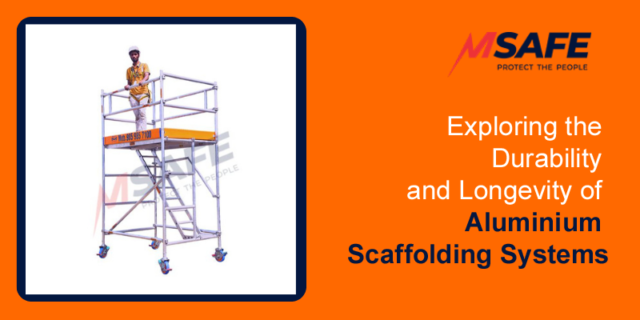Due to its adaptability, durability, and user-friendliness, aluminium scaffolding has exploded in popularity across several sectors.
Whether you are a construction professional, painter, or maintenance worker, aluminium scaffolding provides various advantages that may boost your productivity while assuring safety on the job.
This article will discuss aluminium scaffolding and its characteristics, benefits, and safety measures. Keep reading to get the full details.
Aluminium Scaffolding’s Many Pros
● Easy to carry and transport
Aluminium scaffolding is much lighter than its steel counterpart, making it more practical in transportation, setup, and breakdown. This feature allows for easy installation and reduces labour costs on building sites.
Safety is prioritised in the creation of aluminium scaffolding. It’s a safe place to work that won’t topple over. Thus, fewer injuries will occur. Thanks to the non-slip surface, a solid grip is guaranteed even in wet or slick circumstances.
● Aluminium’s Adaptability as a Scaffolding Material
Aluminium scaffolding systems are recognised for their adaptability, making them an excellent alternative for numerous construction applications.
Aluminium scaffolding may be modified to fit the requirements of every job, whether it is on a skyscraper, a house, or a restoration. This versatility not only reduces the complexity of scaffolding logistics but also boosts productivity on the job.
Aluminum scaffolding has a significant weight advantage over its steel counterpart.
Because of this, workers on the building site will have an easier time moving about and setting up their equipment. Therefore, employees may save time and effort, resulting in greater output.
Aluminum scaffolding, although being lightweight, does not skimp on safety or durability.
These systems are intended and extreme weather conditions, assuring workers’ safety and the equipment’s life.
Aluminum scaffolding is intended to be quickly and easily assembled, making it ideal for construction sites.
The structure may be rapidly erected with the use of simple locking mechanisms that save time for the workers.
Aluminum scaffolding systems may be easily adjusted in height, making it possible for construction workers to access all building floors simultaneously.
Because of this flexibility, there is no need for frequent disassembly and reassembly, which saves both time and energy.
Scaffolding Maintenance and Repair for Aluminium Structures
Keep your aluminium scaffolding in good condition by following these suggestions for upkeep.
Scaffolding should be cleaned regularly to eliminate dirt, debris, and potentially hazardous chemicals.
Avoid harsh cleaners and scrubbers that might scratch the surface.
The Role of Tower Size in Scaffolding
Choosing a suitable scaffold is more than just checking a box. It’s understandable to feel bewildered when confronted with the market’s dizzying variety of scaffolding solutions.
The demands of your project, however, should serve as a compass in making your decision. The following are crucial factors to think about:
Capacity in Terms of Height and Weight: Accessibility standards for height vary from project to project.
The scaffold tower you choose must be able to accommodate this height safely. These capabilities may usually be gleaned from the manufacturer’s specs.
Choose a scaffold that meets or exceeds the needs of your project every time.
Features of the Base Unit: It is more than simply a place to stand on the scaffold’s platform.
It is the hub of the story’s action. Therefore, there must be sufficient room for people, equipment, and other necessities.
The presence of a guardrail, which acts as the primary barrier against any possible falls, is also crucial.
Slip-resistant surfaces are a bonus, making for a safe and productive platform.
The durability of a scaffold tower determines how long it will last in service.
Since many projects could be outside, a scaffold must resist weather and temperature swings.
How Come We Use Aluminium Frames
Scaffold towers made of lightweight aluminum provide a solution that stands the test of time.
Several qualities of aluminium make it an excellent scaffolding material:
Durable and Lightweight: Due to its lightweight design, aluminium scaffolds facilitate both travel and assembly.
Nevertheless, don’t let their modest weight fool you; they’re just as strong, if not stronger than their bigger counterparts.
Durable in any climate: Aluminium scaffolding is highly recommended for outdoor construction since it is durable and can tolerate extreme temperatures and weather.
Cost-Benefit Analysis and Other Financial Factors
Aluminium scaffolding can be erected and taken down rapidly, saving time and boosting job site efficiency.
Analogy to Other Forms of Scaffolding
Aluminium Scaffolding: Aluminium scaffolding is more manageable and portable because of its reduced weight. It is easier to set up and has more excellent corrosion resistance.
Aluminium scaffolding lasts far longer than its wooden counterpart since it doesn’t decay, bend, or attract insects like wood. It is a more secure and steady work surface.
Types of Scaffolding
Scaffolding systems vary from country to country.
● Scaffolding With A Single Frame
“Bricklayer scaffolding” is often used to refer to single-frame scaffolding. This is frequent scaffolding for masonry and other low-rise building projects because of its simplicity and inexpensive cost.
The vertical standards are firmly planted in the ground, while the horizontal ledgers and transoms combine to create a robust and unified framework.
The versatility of a single-frame scaffold lies in its simplicity of setup and breakdown. However, there are height restrictions, and the structure becomes less stable as more frames are added.
While single-frame scaffolding is a practical option for shorter height requirements, it may not be enough for bigger or higher constructions.
Double-frame scaffolding has two parallel rows of vertical standards compared to its predecessor, single-frame scaffolding. This layout is ideal for heavier construction jobs like plastering and concrete work because of its increased stability and load-bearing capabilities.
The strong support provided by the double rows of standards makes operating safely at more considerable heights possible. The adaptability of double-frame scaffolding has made it popular for use in several contexts.
It is the material of choice for high-stakes building projects because it can support more weight and remain steady at greater heights.
● Scaffolding Tubes
Tubular scaffolding, built from steel tubes and couplers, stands out because of its exceptional durability, lifespan, and ease of installation.
This scaffold system offers safe and solid working platforms at varying heights and is adaptable to various construction jobs.
Its reputation for durability and toughness has made it a standard in the building sector, finding use in industrial, commercial, and residential environments.
● Scaffolding with Ringlocks
Modular in design, ringlock scaffolding is distinguished by its circular connections and horizontal ledgers.
Its fame comes from the ease with which it may be assembled and its rock-solid stability.
This versatile scaffolding system may be used in various industrial, commercial, and residential settings.
One of the most challenging components of building is ring lock scaffolding’s capacity to provide safe work platforms regardless of the ground’s gradient.
Ring lock scaffolding is favored in the construction sector due to its ability to adapt to various situations and its sturdy support system.
Conclusion
Scaffolding made of aluminum is a flexible and effective way to reach higher places in various settings.
Aluminium scaffolding is crucial for building, maintaining, and fixing because of its low weight, safety features, and adaptability.
By following safety procedures, doing regular maintenance, and selecting the proper kind of scaffolding, companies may optimise their production while assuring the safety of their personnel.








